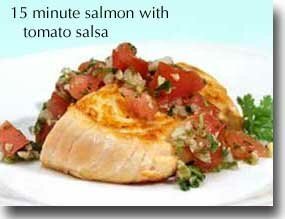Prep and Cook Time: 15 minutes
Ingredients:
- 1-1/2 lbs salmon filet cut into 4 pieces, skin and bones removed
- 1 TBS lemon juice
- salt and pepper to taste
- Salsa
- 1 large fresh ripe tomato, seeds and excess pulp removed, diced small pieces, about 1/2 inch
- 3 TBS finely minced onion
- 3 medium cloves garlic, pressed
- 1-2 TBS minced jalapeno pepper (or to taste)
- 1 TBS minced fresh ginger
- 1 TBS coarsely chopped pumpkin seeds
- 1/4 cup chopped fresh cilantro
- 2 TBS lemon juice
- 1 TBS extra virgin olive oil
- salt and black pepper to taste
Directions:
- To Quick-Broil preheat broiler on high and place an all stainless steel skillet (be sure the handle is also stainless steel) or cast iron pan under the heat for about 10 minutes to get it very hot. The pan should be 5 to 7 inches from the heat source.
- Rub salmon with 1 TBS fresh lemon juice and a little salt and pepper. (You can Quick Broil with the skin on; it just takes a minute or two longer. The skin will peel right off after cooking.)
- Using a hot pad, pull pan away from heat and place salmon on hot pan, skin side down. Return to broiler. Keep in mind that it is cooking rapidly on both sides so it will be done very quickly, usually in 7 minutes depending on thickness (10 minutes for every inch of thickness). Test with a fork for doneness. It will flake easily when it is cooked. Salmon is best when it is still pink inside.
Salsa
- Combine all salsa ingredients.
- Spoon over salmon.
- Garnish with mint and a sprinkle of extra virgin olive oil.
Healthy Food Tip
What is fiber, how is it digested, and why is it important for health?
"Fiber" is a term that sounds quite simple and straightforward, but it's actually been a term of great controversy in nutrition. Traditionally, researchers have described fiber as a group of polysaccharides that resisted breakdown in the digestive tract. However, this definition is not completely accurate since (1) polysaccharides are not the only type of nutrients that share the characteristics of fiber, and (2) many fibers can actually be used by the body after being fermented by bacteria in the large intestine. I like to think about fibers as unique nutrients that belong to several different chemical categories but that share in common one special feature-their tendency to go through the digestive tract in a way that is well protected from digestion and allows them to play roles that other parts of food cannot play.
Another key identifying characteristic of fibers is their exclusive presence in plants and plant foods. Animal foods do not provide us with fiber, only plant foods do. The carbohydrate fibers include celluloses, hemicelluloses, pectins, and fructans (polyfructoses). The primary non-carbohydrate fibers are the lignins that make up an important part of many cell wall structures in plants. Many of the World's Healthiest plant foods contain one or more of these dietary fibers. You'll find dietary fibers in vegetables, fruits, legumes, grains, nuts, and seeds. It's the unprocessed, whole food form of these foods that allows them to provide you with their fiber benefits, however, heavily processed, fiber-rich foods will often lose their fiber-rich qualities.
Much has been written about the health-promoting benefits of fiber, and ample numbers of studies support an association between high-fiber diets and a decrease in risk of many types of cancers, including colon cancer and breast cancer. Some of this benefit comes from the ability of fiber to bind and remove toxins and to promote healthy digestion. Recent research suggests, however, that fiber provides its health-protecting benefits in other ways as well, and one of the most important appears to be its ability to promote healthy intestinal tract bacteria.
Your large intestine contains a multitude of beneficial bacteria that are required for your body's health. They are called the "friendly flora," or the beneficial symbiotic microbes, and they support the health of your whole body by promoting healthy immune function and providing important molecules to your intestinal tract cells to promote their growth, thus sustaining overall intestinal tract integrity. These microbes use some of the fibers you eat as fuel for their own growth, and through their own metabolism produce molecules called short-chain fatty acids (SCFA). SCFA production by this friendly flora has been associated with a decrease in cancerous colonic cells, reduction of serum cholesterol, and maintenance of healthy blood sugar levels and healthy intestinal tract cell walls.
Not all fiber is fermented by the friendly flora in your intestinal tract. Some, as discussed above, goes through your entire system unchanged, binding toxins and waste products as it goes, and promoting healthy elimination. In either case, fibers are unique nutrients when it comes to their health benefits. In order to obtain all of their health advantages, however, it's important for your diet to provide you with a plentiful amount of fiber. This amount is at least 25 grams per day for adult women and 38 grams per day for adult men. The heavily processed nature of the average U.S. diet makes these goals virtually unattainable, and U.S. adults average less than 15 grams of fiber per day. But if you follow the Healthiest Way of Eating, and enjoy a wide range of the World's Healthiest Foods, you'll likely attain-and even surpass-these goals.
"Respect yourself and others will respect you."
www.keralites.net         |
__._,_.___
KERALITES - A moderated eGroup exclusively for Keralites...
To subscribe send a mail to Keralites-subscribe@yahoogroups.com.
Send your posts to Keralites@yahoogroups.com.
Send your suggestions to Keralites-owner@yahoogroups.com.
To unsubscribe send a mail to Keralites-unsubscribe@yahoogroups.com.
Homepage: www.keralites.net
To subscribe send a mail to Keralites-subscribe@yahoogroups.com.
Send your posts to Keralites@yahoogroups.com.
Send your suggestions to Keralites-owner@yahoogroups.com.
To unsubscribe send a mail to Keralites-unsubscribe@yahoogroups.com.
Homepage: www.keralites.net
.
__,_._,___

No comments:
Post a Comment